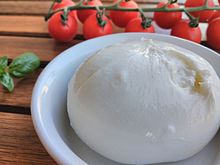Burrata
This article needs additional citations for verification. (March 2011) |
| Burrata | |
|---|---|
 | |
| Country of origin | Italy |
| Region | Puglia |
| Town | Andria |
| Source of milk | Cow |

Burrata (Italian: [burˈrata]) is an Italian cow's milk (occasionally buffalo milk) cheese made from mozzarella and cream.[1] The outer casing is solid cheese, while the inside contains stracciatella and clotted cream, giving it an unusual, soft texture. It is a speciality of the Puglia region of southern Italy.
History
[edit]Burrata is a dairy product of Murgia, in Puglia in southern Italy. It is produced from cow's milk, rennet, and cream, and may have origins dating back to about 1900,[2] produced at the Bianchino brothers' (Lorenzo and Vincenzo) farm in the town of Andria. More recent records have shown that Lorenzo Bianchino, of the Piana Padura farm, first developed the product in 1956.[3]
In November 2016, burrata di Andria became a protected geographical indication (PGI) product.[4][5]
Established as an artisanal cheese, burrata maintained its premium-product status even after it began to be made commercially in factories throughout Puglia.[6]
Burrata is also produced in the United States, particularly in artisanal cheese shops in cities on the East Coast with historically large populations of Italian Americans.[7] Nevertheless, the original burrata di Andria is registered as a protected geographical indication in the EU and UK and all operations, from the processing of the raw materials up to the production of the finished product, must take place in the defined geographical area of the region of Puglia.[8]
Production
[edit]
Burrata starts out much like mozzarella and many other cheeses, with rennet used to curdle the warm milk. Unlike other cheeses, however, the fresh mozzarella curds are plunged into hot whey or lightly salted water, kneaded, and pulled to develop stretchy strings (pasta filata), then shaped.
When making burrata, the still-hot cheese is formed into a pouch, which is then filled with the scraps of leftover mozzarella and topped off with fresh cream before closing.[1] The finished burrata is traditionally wrapped in the leaves of asphodel, tied to form a brioche-like topknot, and moistened with whey.[9]
As burrata does not keep well, even when refrigerated, it is advisable to use it promptly while it is still fresh.[10]
See also
[edit]References
[edit]- ^ a b Contini, M.; Contini, P. (2012). Valvona & Crolla: A Year at an Italian Table. Ebury Publishing. p. 195. ISBN 978-1-4481-4783-0. Retrieved 11 December 2017.
- ^ "Burrata, la regina dei formaggi". Archived from the original on 16 April 2008. Retrieved 30 March 2011.
- ^ "La burrata di Andria. La produzione casearia pugliese in tavola a Roma". Ciclostazione Frattini (in Italian). 13 July 2017.
- ^ "Burrata di Andria PGI". QualiGeo. Fondazione Qualivita. Retrieved 27 July 2024.
- ^ "Commission Implementing Regulation (EU) 2016/2103 of 21 November 2016 entering a name in the register of protected designations of origin and protected geographical indications (Burrata di Andria (PGI))". Official Journal of the European Union. Publications Office of the European Union. 21 November 2016. CELEX:32016R2103. Retrieved 27 July 2024 – via EUR-Lex.
- ^ Hochman, Karen (October 2007). "Burrata Cheese". Cheese-Butter-Yoghurt Product Reviews. The Nibble. Retrieved 17 March 2011.
- ^ Darlington, Tenaya (20 August 2010). "Cheese of the Month: Claudio's Mozzarella". Grid Philly. Archived from the original on 19 August 2016. Retrieved 5 August 2020.
- ^ "Publication of an application pursuant to Article 50(2)(a) of Regulation (EU) No 1151/2012 of the European Parliament and of the Council on quality schemes for agricultural products and foodstuffs: Burrata di Andria (PGI)". Official Journal of the European Union. Publications Office of the European Union. 20 July 2016. Retrieved 27 July 2024 – via EUR-Lex.
- ^ Roberts, Genevieve (2 March 2011). "Burrata: Britain's new Big cheese". The Independent. Retrieved 7 September 2013.
- ^ Ottogalli, Giorgio (2001). Atlante dei formaggi: guida a oltre 600 formaggi e latticini provenienti da tutto il mondo (in Italian). Milan: Hoepli Editore. p. 211. ISBN 978-88-203-2822-1.
